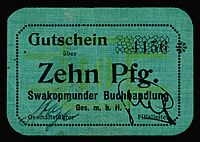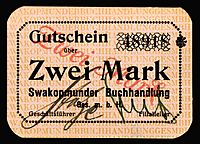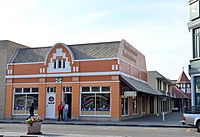Banknotes of the Swakopmund Bookshop facts for kids
Imagine a time when regular money was hard to find. That's when "emergency money" was sometimes used! The Swakopmund Bookshop (Swakopmunder Buchhandlung in German) in a place called Swakopmund printed its own special banknotes. They did this between 1916 and 1918.
These notes were like temporary money. They came in small values like 10, 25, and 50 Pfennig. There were also larger notes for 1, 2, and 3 Mark. Pfennig and Mark were types of money used back then.
What Was This Emergency Money?
These special banknotes were called 'Gutschein'. This German word means something like 'voucher' or 'coupon'. They were used when there wasn't enough regular money to go around.
Why Were They Issued?
During the years 1916 to 1918, the area where Swakopmund is located was under the control of South Africa. Even though South Africa was in charge, these notes still used the names Pfennig and Mark. This was because they were based on the old money system of South West Africa.
It's interesting because even though they used German-sounding money names, these notes are considered real money from the British Empire and the Commonwealth of Nations. This shows how different countries' systems sometimes mixed during those times.
Where Are They Listed?
Sometimes, these notes are mistakenly listed in a big book called the Standard Catalog of World Paper Money. This book is like a huge encyclopedia for banknotes from all over the world. It sometimes lists these notes under 'German South-West Africa' by mistake. But they were actually issued under South African rule.
See also
- South West African banknote issuers




